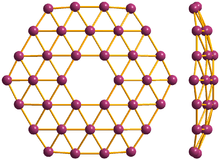Borophene

36° borophene, front and side view
Borophene is a proposed crystalline allotrope of boron. One unit consists of 36 atoms arranged in an 2-dimensional sheet with a hexagonal hole in the middle.[1][2] Another form made in 2015 is a buckled two dimensional sheet on silver.[3]
Theory
Computational studies suggested that extended borophene sheets with partially filled hexagonal holes are stable.[4][5] Global minimum searches for B−
36 lead to a quasiplanar structure with a central hexagonal hole. Borophene is predicted to be fully metallic.[1]
Borophene is analogous to graphene in that it is expected to form extended sheets. The latter is a semi-metal, implying that borophene may be a better conductor.[6] The boron-boron bond is also nearly as strong as graphene’s carbon-carbon bond.[1] At the atomic-cluster scale, pure boron forms simple planar molecules and cage-like fullerenes.[7]
Boron is adjacent to carbon in the periodic table and has similar valence orbitals. Unlike carbon, boron cannot form a honeycomb hexagonal framework (like graphene) because of its electron deficiency.[1]
History
In 2014 a research team at Brown University, led by Lai-Sheng Wang, showed that the structure of B
36 was not only possible but highly stable.[2][6][8] Photoelectron spectroscopy revealed a relatively simple spectrum, suggesting a symmetric cluster. Neutral B
36 is the smallest boron cluster to have sixfold symmetry and a perfect hexagonal vacancy, and it can be viewed as a potential basis for extended two-dimensional boron sheets.[1]
In 2015 a research team synthesized borophene on silver surfaces under ultrahigh-vacuum conditions. Atomic-scale characterization, supported by theoretical calculations, revealed structures reminiscent of fused boron clusters with multiple scales of anisotropic, out-of-plane buckling. Unlike bulk boron allotropes, borophene shows metallic characteristics that are consistent with predictions of a highly anisotropic, 2D metal.[7]
Borospherene

40° borospherene
In July 2014 researchers announced the creation of a 40-atom buckyball-like spherical cage made of boron that the team dubbed borospherene (derived from the original "buckminster fullerene".) Where buckyball molecules feature 20 hexagons and 12 pentagons of carbon atoms producing a smooth spherical surface, borospherene consists of 48 triangles, four seven-sided rings and two six-sided rings. The resulting shape is also spherical, but with several atoms sticking out from the sides.[9][10]
See also
| Look up borophene in Wiktionary, the free dictionary. |
References
- 1 2 3 4 5 "Will 'borophene' replace graphene as a better conductor of electrons?". KurzweilAI. February 5, 2014. Retrieved February 5, 2014.
- 1 2 Piazza, Z. A.; Hu, H. S.; Li, W. L.; Zhao, Y. F.; Li, J.; Wang, L. S. (2014). "Planar hexagonal B36 as a potential basis for extended single-atom layer boron sheets". Nature Communications. 5. Bibcode:2014NatCo...5E3113P. doi:10.1038/ncomms4113. PMID 24445427.
- ↑ Mannix, A. J.; Zhou, X.-F.; Kiraly, B.; Wood, J. D.; Alducin, D.; Myers, B. D.; Liu, X.; Fisher, B. L.; Santiago, U.; Guest, J. R.; et al. (17 December 2015). "Synthesis of borophenes: Anisotropic, two-dimensional boron polymorphs". Science. 350 (6267): 1513–1516. Bibcode:2015Sci...350.1513M. doi:10.1126/science.aad1080.
- ↑ Tang, Hui & Ismail-Beigi, Sohrab (2007). "Novel Precursors for Boron Nanotubes: The Competition of Two-Center and Three-Center Bonding in Boron Sheets". Physical Review Letters. arXiv:0710.0593
 . Bibcode:2007PhRvL..99k5501T. doi:10.1103/PhysRevLett.99.115501.
. Bibcode:2007PhRvL..99k5501T. doi:10.1103/PhysRevLett.99.115501. - ↑ Gonzalez Szwacki, N. (2008). "Boron Fullerenes: A First-Principles Study". Nanoscale Research Letters. arXiv:0711.0767
 . Bibcode:2008NRL.....3...49G. doi:10.1007/s11671-007-9113-1.
. Bibcode:2008NRL.....3...49G. doi:10.1007/s11671-007-9113-1. - 1 2 "New boron nanomaterial may be possible". Brown University. January 27, 2014. Retrieved March 9, 2013.
- 1 2 Mannix, A. J.; Zhou, X.-F.; Kiraly, B.; Wood, J. D.; Alducin, D.; Myers, B. D.; Liu, X.; Fisher, B. L.; Santiago, U. (2015-12-18). "Synthesis of borophenes: Anisotropic, two-dimensional boron polymorphs". Science. 350 (6267): 1513–1516. Bibcode:2015Sci...350.1513M. doi:10.1126/science.aad1080.
- ↑ Johnson, Dexter (January 28, 2014). "'Borophene' Might Be Joining Graphene in the 2-D Material Club". IEEE Spectrum. Retrieved March 9, 2013.
- ↑ Quick, Darren (July 14, 2014). "Borospherene bounces into buckyball family". Gizmag.com. Retrieved 2014-07-14.
- ↑ Zhai, Hua-Jin; Zhao, Ya-Fan; Li, Wei-Li; Chen, Qiang; Bai, Hui; Hu, Han-Shi; Piazza, Zachary A.; Tian, Wen-Juan; Lu, Hai-Gang; Wu, Yan-Bo; Mu, Yue-Wen; Wei, Guang-Feng; Liu, Zhi-Pan; Li, Jun; Li, Si-Dian; Wang, Lai-Sheng (13 July 2014). "Observation of an all-boron fullerene". Nature Chemistry. Bibcode:2014NatCh...6..727Z. doi:10.1038/nchem.1999.